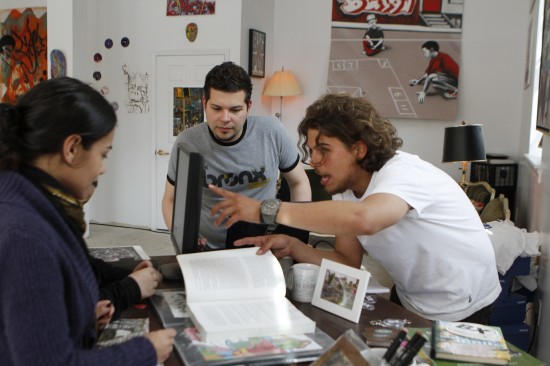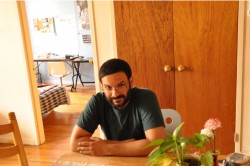
Artists say change defines their relationship with Mott Haven
Hatuey Ramos Fermin sits in the most famous apartment in Mott Haven, recording a podcast called “South Bronx Filter.”
Fermin is the current tenant of Apartment 3A at 309 Alexander Avenue, which housed the Blue Bedroom where for two years his friend Blanka Amezkua displayed the work of contemporary artists who agreed in exchange for the show to offer a workshop or discussion in the neighborhood.

For people like the seven artists gathered around Fermin’s dining table to record the first of his “Hubs and Spokes Conversation Series,” the turnover in Apartment 3A symbolizes the Mott Haven art scene.
They say that galleries and artists may come and go, but the creative energy remains.
“The Bronx is very transient place,” says Ellen Pollen, director of the Bronx Council on the Arts South Bronx Cultural Corridor. “People come here on their way to other places a lot.”
After six years of showcasing local work, the Haven Gallery on Bruckner Boulevard closed in 2009.
More recently, noted Pollen, who runs the Bronx Council’s Culture Trolley, the Iron Works Gallery, at 259 East 134th Street, closed. But, she emphasized, a short time later the trolley added LDR Studio on Alexander Avenue to its itinerary.
“To run a gallery takes a lot of time, and money,” said Barry Kostrinsky, founder of the Haven Gallery, who said the weak economy after the real estate bubble burst hurt. But Kostrinsky can now be found at the Bruckner Bar & Grill on Monday evenings, offering a version of the life drawing classes that used to be a staple at the Haven.
Bronx Arts Space, on East 140th Street, opened a year ago, and draws artists from outside Mott Haven. Avery Syrig, a sculpture and jewelry designer, found it through craigslist.
“It’s looking different, from a newer perspective than a lot of things I see in Manhattan,” she said.
“There seems to be a commitment to get people out to see different work, and not just visual arts,” said Amee Pollock, who displayed pop-up books at Bronx Arts Space during the Bronx Council on the Arts Fifth Open Studio Tour, where sculptures, photographs, video installations and a jazz performance, were highlights.
In May, a new kind of showcase was born, when Bronx artists displayed their work for four days in a pop-up museum created by the Mott Haven-based business From the Bronx in a renovated landmark building on Courtland Avenue in Melrose.
“There’s an emerging sense about culture and people,” says Bill Aguado, who headed the Bronx Council on the Arts for three decades. “What’s important is we have alternative spaces.”
Mott Haven also continues to attract artists to live or work in the neighborhood. When Fermin gathered seven of them to inaugurate his conversation series, the relationship of artists to the community was one of their subjects.
Fermin, a multimedia artist and educator at the Teen Council Program at the Bronx Museum of the Arts and Hostos Community College, devised the South Bronx Filter as a way for Bronx-based artists to express themselves in their own voices. He says he was inspired by Bronx hip-hop photographer, Joe Conzo, who advised: never let outsiders document you.
Recorded in Fermin’s living room, as the open windows captured the noise of cars whizzing by and sirens from the nearby 40th Precinct, the conversation included Libertad Guerra and Monxo Lopez of Spanic Attack, Rayzer Sharp and Yelimara Concepción of the Welfare Poets, and artists Elizabeth Hamby and Laura Napier, the curator of the first Hubs broadcast.
Napier vigorously disputed the notion that when artists arrive, gentrification arrives with them. A white woman who has lived in the Bronx for seven years, she said she’s constantly encountering and fighting against being stereotyped. Too often, she feels “I don’t exist anymore; it’s about the larger social issues,” she said.
Interviews with Bronx based artists, many of whom live or work in former warehouses and manufacturing spaces near Bruckner Boulevard, and with curators and gallery owners showed that they’re fed up with the label SoBro, conceived by real estate sales people to attract clients looking for a hip placed to live.
Recognize us for our work, not our location, they say.
The faces and spaces may change, but the networks forged by artists through the Culture Trolley and Open Studio Tour remain “the social capital” of the Bronx, Pollen contends.
“Artists are looking for community, and take advantage of it when they find it,” she says.
A version of this story appeared in the June/July 2011 issue of the Mott Haven Herald.

[…] Reports of art scene’s death are exaggerated […]
[…] 3 Jun // Share/Bookmark Reports of art scene’s death are exaggerated […]
[…] Reports of art scene’s death are exaggerated […]